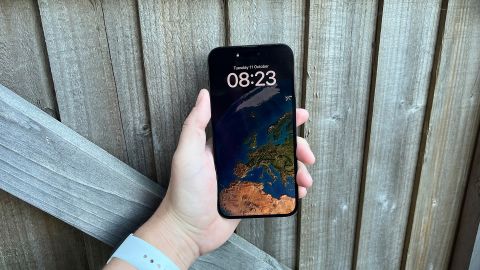Let’s face it, for some reason camera quality in phones is sexier than picture and sound quality. Why else would a brand such as Apple focus each year on bigger sensors with more megapixels while giving nary a mention to screens, speakers or DACs?
The good news is that while Apple rarely shouts about AV upgrades, its new phones regularly contain them, and each new generation of iPhone generally includes better picture and/or sound quality.
That’s what makes the new iPhone 14 Pro Max so exciting: it’s the first new iPhone in ages with an AV upgrade that Apple has deemed worth shouting about. That upgrade is a big increase in brightness.
Interestingly then, it turns out that while the picture quality is certainly improved, it’s by less of a margin than the audio, which hits new highs for smartphone sound.
Price
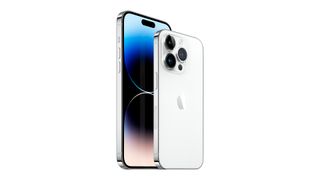
The iPhone 14 Pro Max is priced from £1199 / $1099 / $1899. That makes it £100 / $100 / AU$150 more expensive than the slightly smaller but allegedly otherwise identical iPhone 14 Pro. In each case that gets you a 128GB version of the phone, but there are further storage options, right up to 1TB.
If it’s the Pro Max’s size that’s appealing but you’re not sure whether you truly need its power or camera system, you might want to consider the iPhone 14 Plus, which costs £949 / $899 / AU$1579. The standard iPhone 14, meanwhile, starts at £849 / $799 / AU$1399.
Here's the full pricing in easily digestible table form:
| Header Cell - Column 0 | iPhone 14 | iPhone 14 Plus | iPhone 14 Pro | iPhone 14 Pro Max |
|---|---|---|---|---|
| 128GB | £849 / $799 / AU$1399 | £949 / $899 / AU$1579 | £1099 / $999 / AU$1749 | £1199 / $1099 / $1899 |
| 256GB | £959 / $899 / AU$1579 | £1059 / $999 / AU$1749 | £1209 / $1099 / AU$1899 | £1309 / $1199 / AU$2099 |
| 512GB | £1179 / $1099 / AU$1899 | £1279 / $1199 / AU$2099 | £1429 / $1299 / AU$2249 | £1529 /$1399 / AU$2419 |
| 1TB | No such model | No such model | £1649 / $1499 / AU$2599 | £1749 / $1599 / AU$2769 |
Design
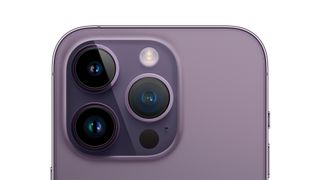
Guess what? The iPhone 14 Pro Max looks very much like the iPhone 13 Pro Max at first glance. Look a little closer, though, and there are notable differences.
For starters, there are new colours. The iPhone 14 Pro and Pro Max are available in silver and gold, which are returning colours, but also Space Black and Deep Purple, which are new. The iPhone 13 Pro's Silver Blue, Alpine Green and Graphite are gone.
Elsewhere, the camera cluster on the rear of the phone is even bigger than before, and the overall dimensions are ever so slightly larger than before, but we're talking tenths of a millimetre.
The biggest news on the design front, though, is the replacement of the notch, which houses various sensors and encroaches onto the screen of the iPhone 13 Pro Max, with the 'Dynamic Island', which houses various sensors and encroaches onto the screen of the iPhone 14 Pro Max in a very different way.
Essentially, the cutout that connected to the top edge of the iPhone is now a discrete, pill-shaped space that dynamically alters in size and shape depending on context. It expands to show information and a neat animation when you play music, for example, and gives extra info and smart graphics when you connect some AirPods. It can be tapped and expanded, too. All told, it’s a neat and inventive solution that’s surprisingly less intrusive than the old notch, though there are occasions where its dynamic actions look awkward, such as when it expands to a square when doing a Face ID check.
One disappointment is that Touch ID has not made its much-heralded return with the new iPhones. Apple would need to incorporate under-screen fingerprint sensing for this feature and it seems the company isn't ready for that yet, so Face ID remains the unlock method for now.
Features
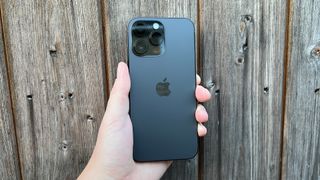
After a couple of generations of screen tech stagnation, there’s potentially exciting news for AV aficionados: while the iPhone 14 Pro Max’s display is no larger (6.7 inches) than that of its predecessor and is essentially identical in pixel-density (460ppi to 458ppi), it is apparently brighter, rising from the 1200 nits of last year to 1600 nits with HDR videos when required.
On the subject of HDR, like its predecessor, the iPhone 14 Pro Max supports the Dolby Vision, HDR10 and HLG formats.
Less exciting from an AV perspective but still very impressive is the iPhone 14 Pro Max’s ability to reduce its refresh rate to just 1Hz. This would be awful for watching content, but it's perfect for conserving power to such a degree that the phone can have an always-on display. Ultimately, the iPhone 14 Pro Max lowers the screen's frame rate (and brightness) when it's locked in order to save battery while still displaying information such as notifications and the time.
In truth, it takes a long time to get used to the always-on display when you first switch to the iPhone 14 Pro Max. Every time you catch the phone out of the corner of your eye you automatically assume you’ve left the screen on or there’s a notification that requires your attention. Changing the lockscreen wallpaper from a picture to pure black helps with this, but it also becomes less distracting over time.
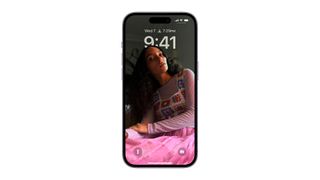
Screen size 6.7 inches
Type OLED
Resolution 2796 x 1290 (460 ppi)
Operating system iOS 16
Finishes x4
Battery life 29hrs video, 95hrs audio
Dimensions (hwd) 161 x 78 x 7.9mm
Weight 240g
Capacity 128GB, 256GB, 512GB, 1TB
The Pro models always offer a little extra something over the other handsets in order to justify their higher price tags, but with the new range Apple has thrown a curveball, with the iPhone 14 Pro models debuting a new, previously unannounced A16 processor, while the non-Pro variants stick with the A15 Bionic from the iPhone 13 range.
That's a pretty big deal, as Apple usually uses the same chipset across its entire iPhone range. In fact, it had previously done so with every iPhone since the iPhone 5S and 5C landed with different processors in 2013. Usually, what differentiates the Pro and non-Pro models are more cores or more memory along with a few extra camera features. The different processors draw a real line between the two ranges.
The iPhone 14 Pro Max's A16 chip is one of the first 4nm chips in existence and apparently provides a serious power boost over the 5nm A15 Bionic. Apple says its CPU uses 20 per cent less power than the A15, while its GPU is said to boast 50 per cent more memory bandwidth. All told, the company claims the A16 is the "fastest chip ever in a smartphone". Certainly, the new Pro Max is flawlessly fast and stutter-free in use, but it’s not as if last year’s model ever felt sluggish. Of course, advanced features such as the Dynamic Island may not have been possible with the previous silicon.
While the processor is faster, battery life remains roughly the same as before. Apple’s claim of around 25 hours of constant steamed video roughly tallies with our own testing, and you can expect to get about 14 hours of constant, heavy use out of the phone – more than anyone is likely to put it through. In other words, you’ll get at least a day of regular use out of the phone between charges, and it’s not particularly tricky to get the battery to last two days.
The headline feature of the iPhone 14 Pro's camera is a 48MP main sensor with a quad-pixel sensor. That's a huge improvement on the 12MP found on the iPhone 13 range, although there are phones out there with even more impressive numbers, such as the Samsung Galaxy S22 Ultra and its 108MP main sensor.
Alongside the iPhone’s main sensor is a 12MP ultrawide with a larger sensor and more focus pixels than before. The result is wide-angle shots that are brighter and punchier. Also, somewhat counterintuitively, the ultrawide is employed in macro photography, which is more detailed and more vibrant as a result of the upgrades.
It’s not simply the sensors that dictate photography quality, though, and the new iPhones (from the iPhone 14 up) use a new ‘Photonic Engine’ – essentially a new combination of hardware and software enhancements – to make the most of your enthusiastic snapping.
Ultimately, while it’s fair to say that camera quality is less of a priority to us than the AV performance, the iPhone 14 Pro Max’s photos are marginally better than those taken on the 13 Pro Max, particularly in low-light conditions.
Picture
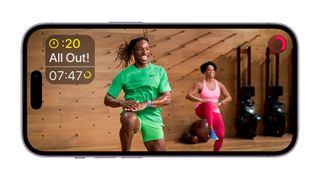
The iPhone 14 Pro Max’s extra nits over its predecessor are immediately obvious as we fire up test favourite Blade Runner 2049, with the white introductory text being clearly brighter against the pure black background. Throughout the meat of this and the many other films we watch during testing, the extra brightness doesn’t appear huge, but it is regularly noticeable in highlights such as the room in which K takes his ‘baseline’ test in Blade Runner and in the sun glinting off the ocean during the intro credits of Top Gun: Maverick.
Also readily appreciable is the new model’s slightly richer tone, which lends skin tones in particular a lovely extra bit of warmth. Colours are marginally more vibrant, too, and this extra vibrancy, while slight, carries through to the brightest parts of the picture, so those regular Top Gun sunsets have a sexier, fuller orange hue.
Taken as a whole though, what’s most noticeable is the iPhone 14 Pro Max’s increased contrast. While both models are capable of producing essentially perfect blacks thanks to their OLED displays, the new Pro goes deeper more regularly, and without sacrificing dark detail. In fact, very dark shades are even more subtly reproduced here, making dark scenes such as those in the sewers beneath Derry in It even more authentic and revealing.
While each of these improvements isn’t massive on its own, combined they produce an image that’s noticeably more solid, three-dimensional and impactful. It’s an exceedingly good picture performance made even better.
If you’re wondering where that leaves the new iPhone in comparison with our favourite Android phone, the Sony Xperia 1 IV, it’s above it. The Xperia is a brilliant phone for movie-watching, but it doesn’t combine dynamism and subtlety in quite the same way as the iPhone 14 Pro Max. You can set the Sony phone up so it goes brighter than its Apple rival, but doing so sacrifices the overall depth of the image and digs up detail that we’re confident the director didn’t intend you to see. Reduce the brightness to adjust for this and it can no longer match the iPhone's pop. Again, it’s a contrast thing – the thrilling combination of super-deep blacks and strikingly bright highlights – that the iPhone gets so right.
The elephant in the room is aspect ratio. The Xperia 1 IV has a very movie-friendly 21:9 ratio, which means the majority of films fill its screen without black bars or cropping. There’s no notch to interrupt the straight edges of the display, either. The iPhone, though, has a slightly narrower screen (its aspect ratio is 19.5:9 if you want to get technical), with rounded corners. Plus, of course, there’s the ‘Dynamic Island’, which creates an oval-shaped black hole on one side of the screen when your video fills it. As a result, purists will instinctively opt to watch films on the iPhone in letterbox mode, where the movie image is smaller and there are fairly hefty black borders around each edge, but where the Dynamic Island is invisible and there’s no cropping at all. We recommend giving full-screen viewing a go, though – the cropping is very slight and it’s rather fascinating how quickly you stop noticing the Dynamic Island, particularly compared to the notch of last year’s 13 Pro Max. The extra size, meanwhile, makes for a much more exciting and engrossing overall experience.
Sound
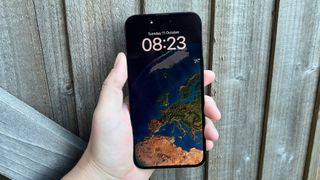
Via headphones, last year’s iPhone 13 Pro Max sounded essentially identical to 2020’s 12 Pro Max. That wasn’t an issue as the sound was already superb and, truth be told, we didn’t think there was much further Apple could take the sound of its iPhones. We were wrong.
The iPhone 14 Pro Max is clearly punchier, more rhythmic, weightier, clearer and more dynamic than its predecessors, and all without any sense of deviation from the creative intent. It doesn’t sound as if the iPhone is colouring or attempting to enhance the source material – it’s instead delivering it with more of its inherent energy and drama intact.
There’s a point in James Blake’s Limit to Your Love when the stark track suddenly springs into a throbbing, multi-instrument arrangement. While it initially sounds perfectly well controlled and engaging via the iPhone 13 Pro Max, the 14 Pro Max’s interpretation is superior across the board, most obviously in the way that it opens up the soundstage and gives every instrument and effect the space to shine while also ensuring that it’s even more rhythmically tied to everything else that’s going on.
Again, these improvements mean the iPhone 14 Pro Max sounds even better than Sony’s Xperia 1 IV, which until now was the best-sounding phone we’d tested. It still sounds great in its own right, but the iPhone’s impeccable timing and even more athletic dynamics make for a sound that’s more exciting and engaging without being any less authentic.
There's less of a dramatic improvement to the 14 Pro Max’s speakers from last year’s model, but there is slightly more warmth and richness to their delivery. It sounds significantly better than the Xperia when playing out-loud, too. We still don’t recommend that you listen to any phone’s speakers unless you really have to, but the iPhone’s will more than suffice if you find yourself without headphones or a wireless speaker.
Verdict
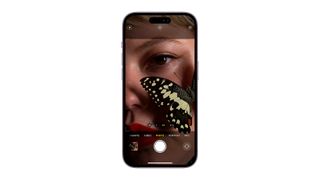
In recent years, each new generation of iPhone has tended to include secret, slight upgrades to picture and/or sound performance, and this is the first time in ages that a significant screen upgrade has been touted. That upgrade is well worthwhile, elevating an already superb video performance to new dynamic levels.
What’s surprising is that the screen upgrade is comfortably trumped by an unpublicised boost to sound quality. The iPhone 14 Pro Max sounds so good, it makes last year’s previously excellent 13 Pro Max sound a little bit dull and congested.
Not only do these upgrades make Apple’s new flagship model the best iPhone yet for portable movie and music lovers, it elevates it beyond the AV benchmark previously set by Sony’s Xperia 1 IV.
SCORES
- Picture 5
- Sound 5
- Features 5
MORE:
Read the full list of What Hi-Fi? Awards 2022 winners
Read our review of the Apple iPhone 14
Also consider the Apple iPhone 13 Pro Max
Read our Sony Xperia 1 IV review
Best smartphones: the best phones for music and movies
- Thinking of upgrading?
- iPhone 15 vs iPhone 14
- iPhone 15 vs iPhone 15 Plus
- iPhone 15 Pro vs iPhone 15 Pro Max
- Thinking of upgrading?
- iPhone 15 vs iPhone 14
- iPhone 15 vs iPhone 15 Plus
- iPhone 15 Pro vs iPhone 15 Pro Max
- Thinking of upgrading?
- iPhone 15 vs iPhone 14
- iPhone 15 vs iPhone 15 Plus
- iPhone 15 Pro vs iPhone 15 Pro Max
- Thinking of upgrading?
- iPhone 15 vs iPhone 14
- iPhone 15 vs iPhone 15 Plus
- iPhone 15 Pro vs iPhone 15 Pro Max
- Thinking of upgrading?
- iPhone 15 vs iPhone 14
- iPhone 15 vs iPhone 15 Plus
- iPhone 15 Pro vs iPhone 15 Pro Max
- Thinking of upgrading?
- iPhone 15 vs iPhone 14
- iPhone 15 vs iPhone 15 Plus
- iPhone 15 Pro vs iPhone 15 Pro Max
- Thinking of upgrading?
- iPhone 15 vs iPhone 14
- iPhone 15 vs iPhone 15 Plus
- iPhone 15 Pro vs iPhone 15 Pro Max
- Thinking of upgrading?
- iPhone 15 vs iPhone 14
- iPhone 15 vs iPhone 15 Plus
- iPhone 15 Pro vs iPhone 15 Pro Max
- Thinking of upgrading?
- iPhone 15 vs iPhone 14
- iPhone 15 vs iPhone 15 Plus
- iPhone 15 Pro vs iPhone 15 Pro Max
- Thinking of upgrading?
- iPhone 15 vs iPhone 14
- iPhone 15 vs iPhone 15 Plus
- iPhone 15 Pro vs iPhone 15 Pro Max
- Thinking of upgrading?
- iPhone 15 vs iPhone 14
- iPhone 15 vs iPhone 15 Plus
- iPhone 15 Pro vs iPhone 15 Pro Max
- Thinking of upgrading?
- iPhone 15 vs iPhone 14
- iPhone 15 vs iPhone 15 Plus
- iPhone 15 Pro vs iPhone 15 Pro Max
- Thinking of upgrading?
- iPhone 15 vs iPhone 14
- iPhone 15 vs iPhone 15 Plus
- iPhone 15 Pro vs iPhone 15 Pro Max
- Thinking of upgrading?
- iPhone 15 vs iPhone 14
- iPhone 15 vs iPhone 15 Plus
- iPhone 15 Pro vs iPhone 15 Pro Max
